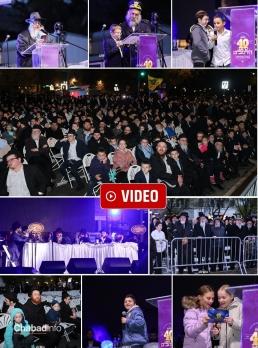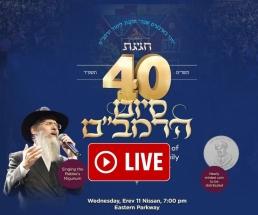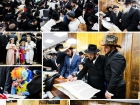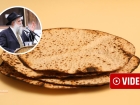Better Than Mindfulness
How Rabbi Adam Stein (Chabad of Stony Brook) Turned a Sicha of the Rebbe into a Jewish Alternative that’s Better than Mindfulness — Meet the Mastermind of StressLess — The Jewish Way to Living in the Moment • Part 2 of an Exclusive Interview by Levi Liberow for Beis Moshiach Magazine, • Full Article
Levi Liberow, Beis Moshiach
“Mindfulness” is all over America today. Though its roots are in the ancient Eastern religions, it has come to be a very popular thing in today’s modern world. The reason: it promises its followers a life free of worry and anxiety.
Last week, Beis Moshiach featured an exclusive interview with Rabbi Adam Stein, Shliach at Chabad House of Stony Brook University, who has developed a program that has come to be known as “A Jewish alternative to mindfulness.”
Rabbi Stein knew nothing about mindfulness when he began. It was “the meat and potatoes of Chassidus” as he says, coming straight out of a sicha of the Rebbe of Parshas Pinchas 5751 (1991), but it was brought to his attention, by some students he was teaching, that it was like mindfulness.
“In fact, the reaction I got from these students who knew the Buddhist stuff, was that this is even better than classic mindfulness for a couple of reasons.”
Why?
Firstly, this is based on machshava and hisbonenus – on logical and intellectual thought. I was teaching methods of hisbonenus which I was taught by my mashpiim which were in essence meshalim (analogies) from our world that Chassidus brings to explain constant creation and presenting them to the course participants.
Hisbonenus, unlike l’havdil other “mindfulness” techniques, brings immediate reaction, whereas other techniques from eastern philosophies are different breathing techniques in which a person clears his mind and breathes in again to further clear the mind. It takes some time until a person can get a geshmak in that. Hisbonenus, by contrast, works immediately. That was the first reason they found it better than the alternatives.
The second reason was that this is based on a higher power – on Hashem. The core of this avoda, the hisbonenus in the fact that Hashem is bringing the world into existence m’ayin l’yesh every second is a power source you cannot find in any of the other Eastern religions!
I’ve done some research and spoke to some people who practiced this stuff and they told me that they have a concept of an infinite energy which isn’t Hashem, and that infinite energy makes as if nothing else exists but this energy cannot create anything and cannot do it at every moment and cannot control all that’s happening.
When they were introduced to the concept of Hashem in Yiddishkeit, that Hashem is all-powerful and always present and controls what happens in the world, they were so impressed that some of these guys came and told me that they believe in this 1000% and that it’s much more powerful!
They told me a third thing — which I mentioned earlier — that what I’m teaching is called “mindfulness,” and it’s the most popular thing in America. I researched it and came out, like I mentioned earlier, with a feeling that this is the Chabad approach to mindfulness — it’s about being mindful of Hashem’s creation of the world yesh m’ayin every moment, which in turn brings to complete peace and tranquility, which is a taste of Moshiach – a taste of that “yom shekulo menucha.” This is the “personal Geula” a person can achieve which can help him achieve a global Geula.
I recall that the Rebbe, when speaking about “kosher meditation,” mentioned that meditation – even in its kosher form – is to be used only as a “medication” and not something a healthy person should pursue. Would you say the same of “Jewish mindfulness”?
Not at all. This is something everyone should be doing. It’s the avoda of Chassidus and Living with Moshiach. I was teaching it simply as Chassidus, and then chanced upon the similarities that mindfulness has to it, but this is something for healthy people too, though it does have therapeutic benefits as well for those who need it.
Not Self Help
I noticed in some of your videos online, that you emphasize that Torah is not a self-help program and that this program of living in the moment is first and foremost about serving Hashem. Can you elaborate?
Absolutely. The point isn’t to be able to live free of stress, but it’s the mitoch shelo lishma ba lishma. It’s an added benefit of living this way and it helps a person do his avoda better.
The Rambam defines the days of Moshiach in terms very similar to living life devoid of stress, worry and anxiety. The Rambam writes that “All of Israel, [in particular,] their prophets and their Sages, have yearned for the Messianic age so they can rest from the [oppression of] the gentile kingdoms who do not allow them to occupy themselves with Torah and mitzvos properly. They will find rest and increase their knowledge in order to merit the world to come.”
Chassidus is Toraso shel Moshiach, a taste of the teachings of Moshiach and Chassidus provides us with tools to “rest so that they can increase their knowledge of Hashem,” so it’s not only a fringe benefit of Chassidus to live devoid of stress, worry and anxiety, it’s actually an “interest” of Chassidus that we can live this way.
Old Requirement, New commitment
We’ve been discussing a lot about being a p’nimi and that that is the avoda of Yemos HaMoshiach, but isn’t that an age-old requirement of Chassidus? The Rebbe quotes the Rebbe Rashab, who probably based it on previous Rebbeim?
Yes, it is an age-old requirement of Chassidus.
However, it was always understood in terms of avoda, where people were categorized as either a p’nimi or a chitzon, with regards to their emotional awakening that was created from deep contemplation on Chassidus.
What the Rebbe did in Parshas Pinchas was to highlight a specific sicha of the Rebbe Rashab, and defining a p’nimi, not solely based on one’s emotional level of avoda, but rather, on one’s intense focus while performing every single machshava, dibbur or maaseh – thought, speech or action.
Once the Rebbe did that, the Rebbe then focused on the concept of “shleimus” – the notion that one can reach complete perfection at any given second in any given machshava, dibbur or maaseh as long as they solely focus on that act and treat that act as a tachlis, a purpose in and of itself.
By doing so, a person experiences a sense of complete perfection that cannot be experienced when a person is running around from one thing to another. For then, everything just seems as if it is just a go-between to achieve some future sense of perfection that cannot be achieved now, at this moment.
A Galus P’nimi Versus a Geula P’nimis
Talking here about the word p’nimi in the context of Moshiach, brings to mind what the Rebbe said in the sicha of Chof Ches Nissan 5751, that no one cares enough if Moshiach won’t come tonight or tomorrow night ch”v, and the Rebbe adds that “the main thing is that we’re in a galus p’nimi in matters of Avodas Hashem.” How do these two problems – the lack of really caring about Moshiach not being here and the galus p’nimi connect?
Let’s define the term “galus p’nimi;” it’s not that you aren’t doing Avodas Hashem, you are! It’s that you’re doing it in a galus way, in an un-p’nimyusdike way. This means that you’re not doing your avoda in a way that you realize that Ein Od Milvado, and instead you think that there is a velt – a world you need to take care of; today you’ve got to do this, and tomorrow you’ve got to do that, and the next day you have to do something else.
If this is your outlook on life, then Moshiach’s coming is something nice and useful, but it doesn’t amount to it being out of the question that Moshiach won’t be here today. But if your living in a “Geula p’nimis,” a life of Ein Od Milvado, then you can really call out “Ad Masai” mit ahn emes, because you want the truth, you want Ein Od MiLavado!
To live Geula, you need to be a p’nimi, and when you’ll be a p’nimi you’ll cry out for Moshiach.
The reason people don’t cry out for Moshiach is because they think their present life is real, and that this life has a continuation worth living for, but if Olam Hazeh is perceived for what it really is, yesh m’ayin at every moment, then this future is fake. And when you’re engulfed by this falsehood, of course you’ll cry out and beg Hashem to bring Moshiach and truth to the world!
Let me play devil’s advocate here: If it’s really all about living “Ein od Milvado”, which I can already do now in galus, then what else do I need? I’ll live Ein Od Milvado, I’ll teach others Ein Od Milvado, and what do I need the Moshiach haklali and the Geula klalis and the Beis HaMikdash for, if I have a perfect Geula pratis and Geula pratsidike day and life?
Then you go to V’ata Tetzave (Kuntres Purim Katan 5752) and the Rebbe shows you that even Rashbi was in galus, though he exemplified this kind of life. This is because if it isn’t something that everyone is doing then it isn’t the real thing for you either – if Hashem’s infinite essence is revealed throughout the entire world, then there cannot be anyone or anything devoid of it.
The “Technicals”
Rabbi Stein is very focused on not leaving the Moshiach message “in the air.” His program strives to, as he says, “to get technical about it” and show how it’s done.
So, let’s get technical. What are the “technicalities” of the program that help us not to fall into the trap of just offering lip service to the concept of living with Moshiach?
The most important tool is hisbonenus.
Because moach shalit al halev (the intellect has dominion over the emotions), when a person thinks about Elokus he will immediately have an emotional reaction. Just like, l’havdil, a person who thinks about pizza, his mouth will begin to salivate, a person who will think about Hashem will immediately begin to feel emotions towards G-dliness.
Rabbi Stein shares another anecdote form presenting this idea to the larger student body:
When I was teaching this hisbonenus method, something I was taught by my mashpi’im, again some non-Jewish students approached me and told me that this too has a name in the world of mindfulness and therapy — its called “guided mental imagery”…
Hisbonenus is “guided mental imagery” in that that it’s about tziyur – imagery. We find in Chassidus all the time the expression “yetzayer b’daato” – describe to yourself mentally. In guided mental imagery, the mashpia guides the student to imagine a concept to himself.
In one of his videos, Rabbi Stein demonstrates one of the “constant creation” mediations. It’s quite a famous one and if you went through the Chabad “system,” you should have been exposed to it – the “thrown rock” mashal.
In his lesson, Rabbi Stein asks us to close our eyes and imagine a rock. Then he asks us to imagine the rock flying in the air. Again – this time on a blank screen – he tells us in his soft voice to imagine the energy that the rock must need to fly that way, and to imagine the rock’s fall and return to earth once that power runs out.
That’s the mashal.
Now imagine the world as the rock. Imagine it existing, and imagine the force that’s propelling it to exist every second. That’s the nimshal – it’s Hashem, and this mental exercise should leave you feeling calmer, knowing that there is that force in you, protecting you and watching over you, so there’s no need to worry…
I try to think to myself after this experience of what I would think if my masphi’im in Yeshiva would come into the shiur and begin talking about “guided mental imagery” and flying rocks… It would probably sound to me like something straight out of a psychologist’s textbook.
I share my thoughts:
I would appreciate to hear your take on this, given your background as someone who didn’t go through the “system”: I’m an “FFB” and we have this kind of built in subconscious “cynicism” towards anyone that comes and starts preaching about hisbonenus and similar things. I guess this comes as a result of an “excess-honesty” that makes us feel that this is something that only great Chassidim of the past were able to do…
“It’s certainly a kelipah…” is all he has to say.
How would you break through this cynicism — built for decades perhaps — especially when this is so relevant to living Moshiach?
I think it’s true that in this generation we don’t have the kochos to do hisbonenus on the level of Reb Itche der Masmid, or Reb Nissan Nemenov — Chassidim that were able to focus their minds for hours on a topic, but you don’t have to start with an hour-long hisbonenus…
To simply sit alone for 30 seconds, for 45 seconds, after learning something and describe it to yourself in your mind, that is something anyone can do. It’s a very superficial hisbonenus, it’s fleeting, but for us its good enough. That’s what I do in my classes, and it’s a good place to start…
The avoda of being a p’nimi seems to require more than a fleeting hisbonenus. I mean, your whole day needs to be a “Geulahday” – how can such a fleeting hisbonenus account for that?
There’s no question we need to keep it up. I can tell you about myself, that when I get lax on the hisbonenus, I begin to go back to my old self… Back to normal – nervous, worried and so on.
Another point is that the small hisbonenus leaves an impact, a roshem as it’s called in Chassidus, on the whole day. You may not feel it on the same level as during davening, but you feel a remnant of it throughout the day if you do it consistently.
Where Do Your Problems Go?
This idea of living in the moment is very Jewish, but we also have a concept of “ha’chacham einav b’rosho,” that a person must have his head in the future and act in a responsible way. How can these two approaches be reconciled?
That’s where the idea of Etzem HaNeshama comes into play, which is a topic for a separate discussion. But very briefly, like the Rebbe says in the sicha of Parshas Noach 5752, that when a person “lives in the moment” by focusing on his “Etzem” which is one with the Essence of Hashem, he can be more successful in fixing his past (teshuva), and addressing his future as well.
Is that bitachon, “Tracht gut vet zein gut”?
Exactly! And the Rebbe’s approach to bitachon, in which you can be totally undeserving of Hashem’s kindness, but because you have bitachon you become deserving, illustrates that exactly. How living in the present moment impacts both past and future in a positive way.
By the way, the course and the Kuntres I prepared, develop each of these themes at length.
How does that tie in to the avoda of Etzem HaNeshama?
When you see yourself as a part of Hashem, everything else becomes unimportant and insignificant, so it becomes a lot easier to repair it. The Rebbe gives the example of a superficial sickness that affects you externally only. The mistakes of your past are only external. You view yourself as much more elevated than that. You’re way beyond it!
And that all ties in to “Living in the Moment.” Rabbi Stein starts to speak animatedly: You think you’re a jerk? Fine! The question is why do you think you’re a jerk? Because you were a jerk yesterday? Because you were a jerk the day before? Because you’re a terrible person? Because your parents hate you?
Really? That’s why you’re a jerk? Because you have been one for the past twenty years? Then you really will never change and you will stay a jerk for another twenty years.
But if you live the moment, and the only moment you’re a jerk in is now, then you can easily change that. Remind yourself of you Etzem HaNeshama and that you are truly a tzaddik, the problem fades away easily.
Does it Work?
It sounds nice, both on an avoda level, and for the Nefesh Habehamis to be “free of stress, worry and anxiety,” but does it really work?
100%! I’ve been teaching this for five years to over 3000 students and you can read all the reviews online on my website. They all say that through the duration of these course – seven weeks – they experienced reduced levels of stress and anxiety.
The reason why the course is so popular is because it works – you can see it all for yourself in the testimonials.
Actually, we conducted research on this, and participants filled out anxiety tests before and after the course and the results were a 20 to 80% decrease in their anxiety levels!
Wow! That’s impressive! Is this recommended for every age? Can a Mesivta bochur of high-school age do it, for example?
I have no personal experience with this age group, but in the sicha the Rebbe says that “Men, women and children need to be involved in the avoda of mach da Eretz Yisrael.” I don’t see a reason why a Mesivta bochur shouldn’t be able to do this.
From browsing your website, RedefineTime.com, I see that you offer a program training life coaches in this method.
Yes. Once a person knows these hisbonenuyos, these meditations, he can pass them on to others and we therefore developed this training. The inspiration came from the sicha itself where the Rebbe calls everyone to emulate the lots that were used to divide up Eretz Yisrael and “speak out” as they did — to reach out to others and bring them this message of living in the moment – “Mach da Eretz Yisrael.”
I took this literally and created a program to train people to spread this further and help others live free of stress worry and anxiety – to live Moshiach.
A Vision the World Is Waiting to Hear
I’d like to move on to discuss some inyanei haklal with you. We’re standing now two and a half decades after Gimmel Tammuz and we are committed to spreading the Rebbe’s Besuras HaGeula to the world. But I feel that we’re stuck somewhere and we’re not getting it out in the right way. I don’t think we present as something relevant to people, and a program like yours has great potential – I think – to make Moshiach relevant. How can we “sell” such a thing to the world?
Well, I don’t feel that I can tell everyone what to do, but this is my theory and this is what I’ve been doing:
When a person really believes that by living in the moment, he’s actually putting himself into a situation of Geula – as the Rebbe teaches; and that this actually speeds up the general Geula – as the Rebbe says there too; and that the Rebbe urges us to get this message out to anyone within our reach:
Then we look at the world which was created for me – bishvili nivra ha’olam – to use it to serve Hashem, and I see that Hashem created this thing called “mindfulness,” and that the entire country — I mean medical science, psychiatric science, and literally everyone – is pushing to “live in the moment without stress, worry and anxiety” from the Buddhist perspective, it becomes obvious to me that Hashem created this so we can provide an alternative to it!
We have a responsibility to koch in this and become the leaders of this movement of “Living in the Moment” and channel it in the right direction — a G-d based, Torah based, Moshiach based movement!
Because what we have comes from the Rebbe and works better than theirs!”
How do you see this translating into Moshiach awareness for people who aren’t yet familiar with the ideas of Moshiach?
When a person lives with this awareness of Hashem creating everything yesh m’ayin and that all is good because it’s from Hashem, he “opens his eyes” and becomes a positive person who can perceive the signs of the Geulah in the world.
The best would be if it all happens itself. When someone internalizes these perspectives, you don’t need to preach to him anything about Moshiach, it all flows in memeila – that’s the way a p’nimi lives – everything fits it.
That makes people receptive to the idea that there is a Geula happening, it’s the light of Erev HaGeula, like the light of Erev Shabbos that’s moving the world towards its ultimate goal, because the world is ready for this Gilui HaEtzem.”
As I hear this vision, I realize that while some people have a hard time appreciating that we’re in a generation of Geula by pointing to the many social and emotional hardships people go through these days, it’s worth reminding ourselves that a century ago people didn’t have time or money for emotional issues, and the fact we have it now is a clear sign of Moshiach in and of itself.
***
As we wrap up this hour-long discussion, Rabbi Stein shares how our readers can get some further resources on this crucial topic:
“By the time this interview will be read, I will have launched a new online class which is much easier to follow than the ones I usually have and is even easier than the Chabad.org one. It’s called “7 Day Stress-Less” and it can be accessed at 7DayStressLess.com. It’s an easy-to-do course, not requiring a lot of effort and much more concise. You can do it all in just seven days and feel a noticeable difference.
“And its free!” Also, the full kuntres is available for free download, at RedefineTime.com/kuntres.
Rabbi Stein is available for farbrengens, workshops and speaking engagements and can be reached at [email protected]
*
The magazine can be obtained in stores around Crown Heights. To purchase a subscription, please go to: bmoshiach.org
289
Join ChabadInfo's News Roundup and alerts for the HOTTEST Chabad news and updates!










































